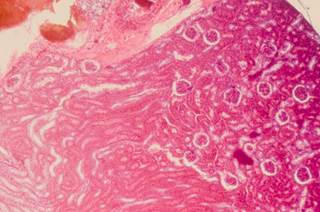|
Bute kidney patient's dialysis petition - Buteman |
 |
 |
A Rothesay man has launched a petition calling on NHS Highland to bring local kidney dialysis services to Bute as soon as possible.
Joe Johnstone launched his petition after speaking to The Buteman about his experiences of travelling to Inverclyde Royal Hospital in Greenock three times every week for dialysis treatment.
Joe, the youngest of four island residents currently forced to travel to the IRH for the treatment (though he has told us that number will soon rise to six), spoke to us in the week that he and his fellow patients had to have their treatment cut short after bad weather disrupted the island’s ferry services.
“It was a nightmare - we were one hour late and our treatment had to be cut,” Joe said. “If it happens once your body can just about live with it but you can’t take the risk of it happening again and again.”
|
|
Medical fund set up for Pampa man with Renal Cell Carcinoma - Pampa News |
 |
 |
|
Posted: Saturday, February 28, 2015 6:00 am | Updated: 3:44 pm, Sat Feb 28, 2015.
Medical fund set up for Pampa man with Renal Cell Carcinoma Submitted thepampanews.com |
Joey Slagle is a mechanic with Stokes Radiator Service in Pampa.
Joey began having some painful physical symptoms soon after losing his mom, just before Thanksgiving. After many tests, Renal Cell Carcinoma was diagnosed as the mass which has invaded his left kidney.
An online service is needed to view this article in its entirety. You need an online service to view this article in its entirety.
Have an online subscription?
Login Now
Login
Need an account? Create one now.
kA 4=2DDlQAbQms6DA:E6 @7 9:D A2:?7F= 4@?5:E:@?[ y@6J 4@?E:?F6D E@ H@C< 2E 9:D ;@3 2D >F49 2D 96 :D 23=6 :? @C56C E@ AC@G:56 7@C 9:D 72>:=J]k^Am kA 4=2DDlQAbQmy@6J 2?5 |:496=6 92G6 EH@ 49:=5C6?[ 286D `a 2?5 `d[ 2?5 C646?E=J 92G6 E2<6? =682= 4FDE@5J @7 E9C66 ?6A96HD[ 286D[ D:I[ E9C66 2?5 `d >@?E9D] %96 ?6A96HD H@F=5 92G6 @E96CH:D6 364@>6 H2C5D @7 E96 DE2E6]k^Am kA 4=2DDlQAbQm$@ 72C[ y@6J’D 6IE6?565 72>:=J 92D 366? 23=6 E@ A2J 7@C 5@4E@CD’ G:D:ED 2D H6== 2D C25:@=@8:DED[ 2?6DE96D:@=@8:DED 2?5 D:>:=2C AC@76DD:@?2=D W2=D@ 52J DFC86CJ 2?5 2== @E96C E6DED[ H9:49 92G6 366? ?F>6C@FDX] qFE H:E9 E96 AC:>2CJ >2;@C DFC86CJ 2AAC@249:?8 :? |2C49[ H9:49 H:== 7:CDE 2EE6>AE E@ C6>@G6 E96 >2DD[ 3FE >2J C6BF:C6 E96 C6>@G2= @7 A2CE @C 2== @7 E96 <:5?6J[ y@6J 2?5 9:D 72>:=J’D 23:=:EJ E@ A2J H:== 72== D9@CE @7 H92E :D ?646DD2CJ 2?5 C6BF:C65]k^Am kA 4=2DDlQAbQmu@C 2?J@?6 H9@ H@F=5 =:<6 E@ 96=A y@6J H:E9 E96D6 6I46DD:G6 4@DED[ 2 7F?5 92D 366? 6DE23=:D965 2E r23@E rC65:E &?:@? :? !2>A2 :? y@6J’D ?2>6] #2?5J 2?5 !2> r2CE6C[ y@6J’D 4@FD:?[ H:== 36 :? 492C86 @7 2== C64@C5D 2?5 5:D3FCD6>6?ED 7C@> E9:D 7F?5] p== AC@4665D H:== 36 5:C64E65 6I4=FD:G6=J E@ >65:42= 6IA6?D6D] %96 72>:=J H:== 4@?E:?F6 E@ 96=A A2J 7@C EC2G6=[ =@58:?8 2?5 @E96C :?4:56?E2= 6IA6?D6D[ 2?5 @7 4@FCD6 H6 H:== 2=D@ 4@?E:?F6 E@ 96=A A2J >65:42= 6IA6?D6D 2D >F49 2D H6 2C6 23=6 E@ 5@ D@]k^Am kA 4=2DDlQAbQm(96E96C J@F 42? 4@?EC:3FE6 >@?6E2C:=J @C ?@E[ E96 72>:=J C6BF6DED J@FC AC2J6CD @? y@6J’D 3692=7] %96 72>:=J D2JD AC2J6C >2<6D 2 5:776C6?46[ 2?5 E96 4@>>F?:EJ’D H:== >2<6 2 5:776C6?46 2?5 2C6 8C62E=J 2AAC64:2E65] (96? E96 7F?5 :D 4=@D65[ 2?@E96C 2CE:4=6 H:== 36 A@DE65 :? E96 ?6HDA2A6C]k^Am
Thank you for reading 2 free articles on our site. You can come back at the end of your 30-day period for another 2 free articles, or you can purchase a subscription and continue to enjoy valuable local news and information. If you need help, please contact our office at 806-669-2525. You need an online service to view this article in its entirety.
Have an online subscription?
Login Now
Login
Need an account? Create one now.
Posted in City, Community, Features on Saturday, February 28, 2015 6:00 am. Updated: 3:44 pm.
|
|
|
Body Mass Index Predicts Survival in Metastatic Clear Cell Renal Cell Carcinoma - Cancer Therapy Advisor |
 |
 |
February 28, 2015

BMI predicts survival and overall response rates in patients with metastatic clear cell renal cell carcinoma.
ORLANDO—Body mass index (BMI) predicts survival and overall response (ORR) rates in patients with metastatic clear cell renal cell carcinoma, according to authors of an external validation data analysis (Abstract 405) presented during the 2015 Genitourinary Cancers Symposium.1
“We validated BMI as an independent prognostic factor for improved survival in metastatic renal cell carcinoma (mRCC),” reported lead study author Laurence Albiges, MD, PhD, of the Dana-Farber Cancer Institute in Boston, MA. "Given that this finding was observed in clear cell RCC only, we hypothesize that lipid metabolism may be modulated by the fat laden tumors cells.”
FASNgene expression was associated with overall survival (OS) in one of the two cohorts analyzed, and the authors said the role of fatty acid metabolism in mRCC demands further exploration.
“BMI is associated with OS independently of FASN,” however, Dr. Albiges reported.
The authors sought to shed light on the so-called obesity paradox. “Obesity is a risk factor for renal cell carcinoma (RCC) and a poor prognostic factor across many tumor types,” Dr. Albiges explained.
“However, reports have suggested that RCC developing in an obesogenic environment may be more indolent. We recently reported on the favorable impact of BMI on survival in the International mRCC Database Consortium (IMDC). The current work aims to externally validate this finding and characterize the underlying biology.”
The study authors analyzed data from patients with mRCC who had participated in Pfizer-sponsored phase 2 and 3 clinical trials of targeted therapy during 2003 through 2013, to determine the associations between BMI and OS. .
High-BMI (25 kg/m2 or higher) was associated with significantly longer OS (median OS: 25.6 months vs 17.1 months in patients with lower BMI (less than 25 kg/m2); HR=0.84, 95% CI: 0.73-0.95; P=0.0079).
RELATED: Proteomic Markers Might Predict Clear Cell Renal Cell Carcinoma Survival
“Additionally, we analyzed metastatic pts from the clear cell RCC cohort of TCGA [The Cancer Genome Atlas] dataset to correlate the expression of Fatty Acid Synthase (FASN) with BMI and OS,” Dr. Albiges said.
At the time of initiation of targeted therapy (TT), 1,829 (39%) patients in that external validation cohort were normal or underweight (BMI <25 kg/m2) and 2,828 (61%) were overweight or obese (BMI ?25 kg/m2), Dr. Albiges reported. In multivariate analyses, the high BMI group had a longer median OS (23.4 months) than the low BMI group (14.5 months; hazard ratio [HR]=0.83; 95% CI: 0.743-0.925; P=0.0008).
High-BMI patients also had better PFS (HR=0.821, 95% CI 0.746-0.903; P<0.0001) and ORR (odds ratio=1.527, 95% CI: 1.258-1.855; P<0.001).
“These results remain valid when stratified by line of therapy,” noted Dr. Albiges. “When stratified by histological subtype, the favorable outcome associated with high BMI was only observed in clear cell RCC.”
Toxicity did not differ between BMI groups.
“FASN staining in the IMDC cohort is ongoing to better investigate the obesity paradox in mRCC,” Dr. Albiges reported.
Reference
- Albiges L, Hakimi AA, Lin X, et al. The impact of Body Mass Index (BMI) on outcomes of patients with metastatic renal cell carcinoma treated with targeted therapy: An external validation data set and analysis of underlying biology from The Cancer Genome Atlas. 2015 Genitourinary Cancers Symposium. Abstract 405.
|
|
Proteomic Markers Might Predict Clear Cell Renal Cell Carcinoma Survival - Cancer Therapy Advisor |
 |
 |
February 28, 2015

Protein expression markers predict disease-specific survival in clear cell renal cell carcinoma.
ORLANDO—Protein expression markers predict disease-specific survival (DSS) in clear cell renal cell carcinoma (ccRCC), according to research (Abstract 406) presented during the 2015 Genitourinary Cancers Symposium.1
“We have identified and validated proteomic signatures which cluster ccRCC patients into five prognostic groups,” reported lead study author Samuel D. Kaffenberger, MD, of the Memorial Sloan Kettering Cancer Center in New York, NY. “Furthermore, two distinct mTOR-activated clusters—one with high receptor tyrosine kinase (RTK) activity and one with increased mTOR pathway genomic alterations—were revealed, which may have prognostic and therapeutic implications.”
The study authors ”sought to leverage reverse phase protein array (RPPA) data from The Cancer Genome Atlas (TCGA)” with an independently developed proteomic platform to identify druggable targets and pathways associated with prognosis in ccRCC, Dr. Kaffenberger said.
They conducted pathway analysis for differentially expressed proteins and assessed associations with clinicogenomic factors and DSS.
“RPPA clustering of 324 patients from the ccRCC TCGA [cohort] revealed five robust clusters characterized by alterations in specific pathways and divergent prognoses,” Dr. Kaffenberger explained.
Both clusters 1 and 2 showed evidence of downstream upregulation of mTOR.
Cluster 1 was characterized by poor DSS, decreased expression of RTK and upregulation of the mTOR pathway, and was associated with mTOR pathway genomic alterations, sarcomatoid histology, and the ccB prognostic mRNA signature (all Ps <0.001).
Cluster 2 was characterized by increased expression of RTKs “and interestingly, had upregulation of the mTOR pathway with excellent DSS,” Dr. Kaffenberger noted. Whereas cluster 1 was associated with worse survival, cluster 2 was associated with superior DSS. After accounting for stage and grade in multivariate analysis, cluster designations remained independently associated with DSS (hazard ratio=0.23 for cluster 2; 95% CI 0.08-0.68; P=0.008).”
“Cluster 1 was associated with universal downregulation of the RTK pathway,” Dr. Kaffenberger noted. “Conversely, cluster 2, which was also associated with upregulation of the mTOR pathway, was associated with universal upregulation of the RTK pathways.”
The study authors subsequently performed an external validation analysis with a separate cohort of 189 patients, using a different proteomics platform—a panel of phosphoproteins (pHER1, pHER2, pHER3, pSHC, pMEK, pAKT) that were highly discriminant between clusters 1 and 2, Dr. Kaffenberger reported.
RELATED: Adjuvant Sorafenib, Sunitinib for Advance Renal Cell Carcinoma 'Should Not Be Pursued'
In the external validation cohort, patients with mTOR pathway activation were segregated into two groups: those with coincident high-RTK activation (83 patients) and those with low RTK activation (13 patients). A univariate comparison of DSS in these high- versus low-RTK score groups found a significant difference: DSS hazard ratio=0.19 (95% CI: 0.05-0.082; P=0.03).
“We found that we were able to accurately stratify patients with clear cell RCC based purely upon protein expression, and furthermore, we found that this stratification was independently prognostic,” Dr. Kaffenberger concluded. “We validated this data with a separate patient cohort and a separate proteomics plastform.”
Following the external validation analysis, RPPA was adapted to predict responses to mTOR inhibitor (mTORi) therapy, using a novel RPPA antibody panel. Preliminary results suggest the novel RPPA panel can predict response to mTOR inhibition, and the researchers are now pursuing study of a larger cohort of mTORi responders.
Reference
Kaffenberger SD, Ciriello G, Winer AG. Proteomic stratification of clear cell renal cell carcinoma utilizing The Cancer Genome Atlas (TCGA) with external validation. 2015 Genitourinary Cancers Symposium. Abstract 406.
|
|
 Log in to explore the world's most comprehensive database of dialysis centres for free!
Log in to explore the world's most comprehensive database of dialysis centres for free!  Professional dialysis recruitment
Professional dialysis recruitment




